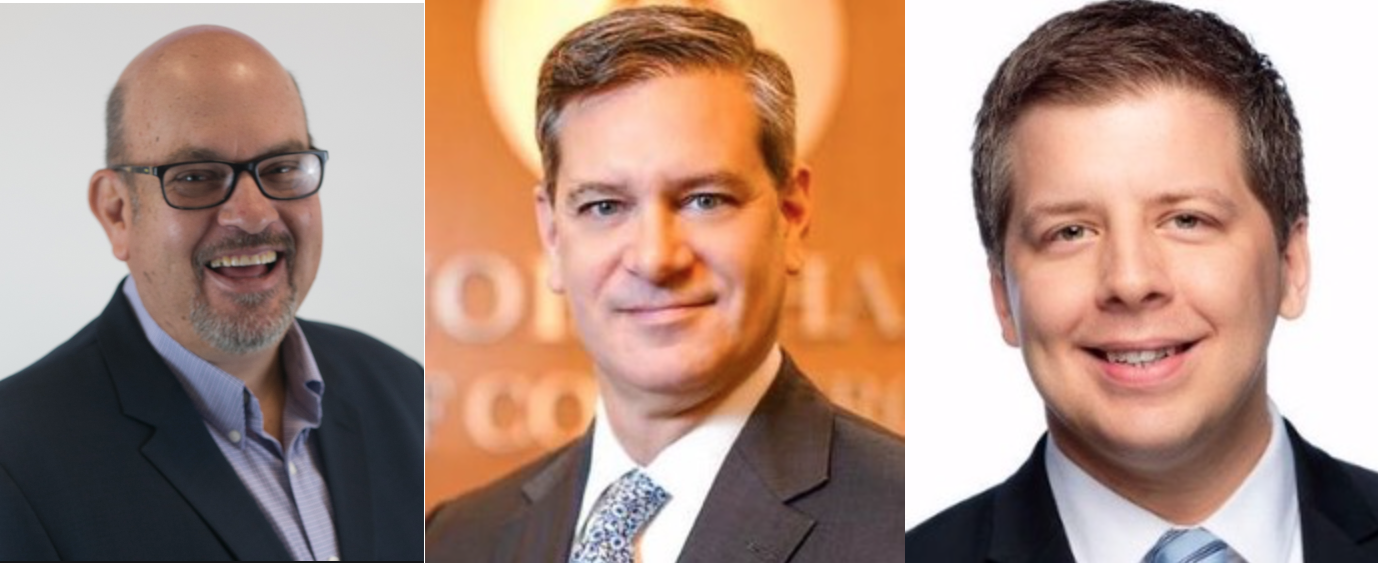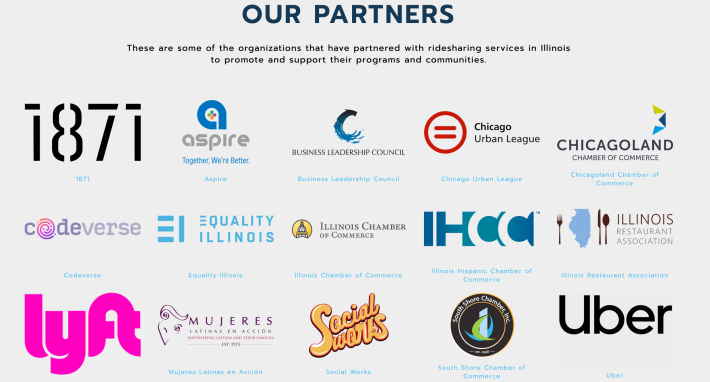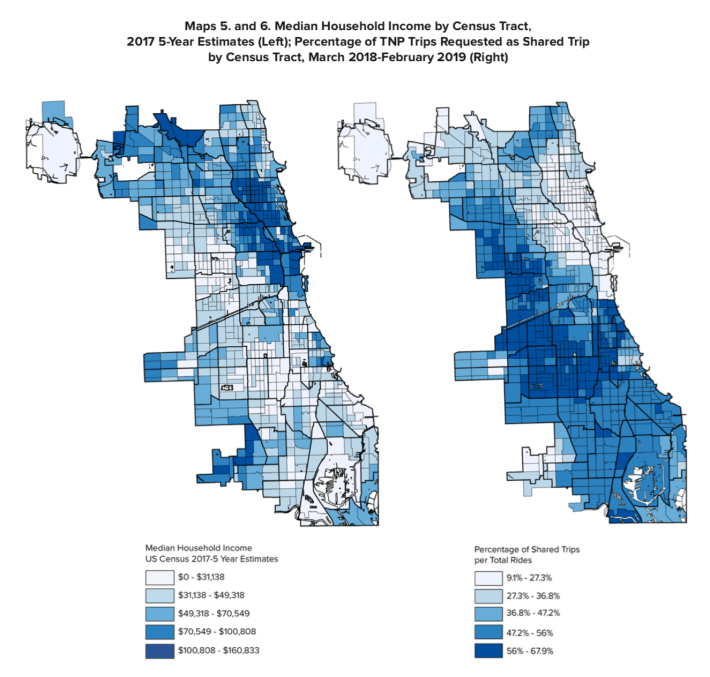That misleading Crain’s op-ed by Uber proxies against the fair ride-hail tax plan, annotated
8:25 PM CST on November 11, 2019

Di Paolo, Maisch, and Reever.
The Active Transportation Alliance has launched a petition where you can voice your support for fair ride-hail fees and better CTA service to elected officials. Add your name to the petition here.
In case you missed it, last week Crain's Chicago ran an excellent piece by columnist Greg Hinz on Mayor Lori Lightfoot's plan to raise the tax on traffic-clogging solo and downtown ride-hail trips, while lowering the fee for more sustainable shared rides in the neighborhoods, and earmarking about $2 million of the revenue annually to fund transit. He did a great job of explaining why, despite Uber and Lyft's self-serving claims that the initiative would hurt South and West side residents, "in fact, it targets Lincoln Park types, and it is intended to shore up CTA service that is far more important."
However, this weekend Uber tweeted out an earlier Crain's op-ed on Lightfoot's proposal, written by some of its official allies in local chambers of commerce, which is full of misleading -- or even downright false -- statements about the plan. The piece was penned by Illinois Hispanic Chamber of Commerce head Jaime Di Paulo, Illinois Chamber of Commerce chief Todd Maisch, and Chicagoland Chamber of Commerce senior vice president Michael Reever. All three organizations are listed as partners of Moving Illinois Forward, a lobbying group for Uber and Lyft. Let's take a look at some of the claims from their op-ed.

These new fees will certainly dissuade people from dining and traveling downtown, which will have a negative impact on jobs for workers.
The new fee structure will raise the tax on private rides downtown during peak hours (weekdays from 6 a.m. to 10 p.m.) from the current $0.72 to $3.00. But that's appropriate because these kinds of trips are a luxury that has worsened downtown congestion in recent years. According to a new city study, the number of ride-hail trips during these times increased by 309 percent from 2015 to 2018. Therefore the significant hike in the surcharge is a feature, not a defect -- it will encourage people traveling downtown to instead opt for one of the many more sustainable and more affordable options, including Uber Pool and Lyft Line, the CTA, and Metra.
Further, if the tax is implemented as proposed, people that use ride-sharing services like Lyft and Uber will see an increase of nearly 300 percent in the amount of taxes they pay, which are already some of the highest in the nation.
This statement is just plain untrue. The only people who will see that $0.72 to $3.00 increase are those taking unsustainable private trips downtown during peak hours. The tax on shared downtown trips during peak hours and private trips in the neighborhoods will only go up by $0.53, to $1.25, a 74 percent increase. That increase is about the price of a round of pinball. Moreover, the tax on shared rides in the neighborhoods will drop to $0.65, a 10 percent decrease.
Update: After I brought this issue to the attention of Crain's editors, to their credit, they made a correction to the false statement. Here's how the above passage now reads (emphasis added):
Further, if the tax is implemented as proposed, people that use ride-sharing services like Lyft and Uber will see an increase of as much as 300 percent in the amount of taxes they pay on certain trips, which are already some of the highest in the nation. That 300% tax increase would apply to downtown private trips during peak hours (6 a.m. to 10 p.m.)
Moving on, let's check out some of the other statements in the op-ed.
If approved, these new fees will have the greatest impact on those who don’t have public transportation options to get downtown for work. If this plan is adopted in the mayor’s new budget, those who use [ride-hail] to get downtown are going to have to make some serious decisions on how they get to work or even what jobs they can take or keep.
This is just silly. If getting to a downtown job solely by transit isn't a practical option for you, taking Uber or Lyft to the nearest 'L' or Metra station probably is. Moreover, it will save you a lot of money and possibly even some time compared to taking a car downtown in traffic. And if you can currently afford to be chauffeured several miles to the Loop in a private car on a regular basis, chances are you're affluent enough that an extra $2.28 isn't going to bankrupt you.
Riders traveling within the neighborhoods often use it to go to local retailers and restaurants and for doctor visits. If we continue to raise these taxes, it will have a negative impact on those businesses, their employees and the amount of revenue raised by the city each year.
People were going to all these places before Uber and Lyft existed -- they were just getting there by more sustainable modes. Studies have shown that ride-hail trips typically replace transit, walking, and bike trips, rather than private car journeys. For many Chicagoans, paying an extra $0.53 for a private neighborhood ride won't be a big deal; others can switch to shared rides and pay less than before. If the new tax makes people shift back to non-car modes, terrific. Either way, the impact on local businesses will almost certainly be negligible.
Raising taxes... will inevitably cause people to take fewer rides, which will only lead to less economic opportunities for the people who drive for a ride-sharing company as their primary or supplemental income source.
Well, yeah, reducing the number of Uber and Lyft rides -- and the associated congestion, pollution, and crashes -- is one of the main reasons for the new tax structure.
But the financial impact on Uber and Lyft drivers does need to be considered, even though it's not as if the companies have been particularly interested in helping their workers make a living wage in the past. The obvious solution is capping the number of drivers. An ordinance requiring the companies to pay their drivers a higher commission would also be a great idea.
The root of this proposal is aimed at reducing congestion downtown, which we can all agree is an issue. With more people living and working downtown than ever before and increased dedicated bus and bike lanes, ride-share is just one of the many contributing factors to our city’s downtown congestion.
New bus lanes and bike lanes are contributing factors to downtown congestion? Nope, to reduce traffic jams we need to build more of these facilities, which encourage people to use space-efficient travel modes.
In contrast, individual Uber and Lyft vehicles ferrying around solo customers is an incredible waste of limited downtown street space. According to the city study, 8,132 ride-hail drivers complete downtown 25,807 passenger trips during a typical morning rush hour, and 9,326 drivers complete 29,817 passenger trips during the evening rush. That adds up to 26 miles of downtown road space occupied by ride-hail vehicles during the p.m. rush.
Meanwhile, CTA buses can carry three times as more people in and out of downtown during the rush period while occupying 5 times less road space. Bus lanes mitigate congestion; Uber and Lyft cause it.
We strongly encourage a comprehensive study be conducted to determine the causes of congestion and develop a holistic plan to mitigate congestion during peak travel times.
The mayor's plan calls for using the new ride-hail tax revenue to fund that very study, which will help pave the way for downtown congestion pricing for private vehicles as well, which would be hugely beneficial for helping people get around downtown efficiently.

This proposal... balances the budget on those that can least afford it.
As you can see from the above chart from the city study, most Uber and Lyft trips hailed in low-income areas and on the South and West sides are shared trips to other neighborhoods. Therefore, most residents in these parts of town who use ride-hail will save money under the new structure. Meanwhile, about 70 percent of trips hailed on the North Side and downtown are private, which means that the new revenue will primarily come from Chicagoans who can most afford it.
Click here to add you name to Active Trans' petition in support of the fair ride-hail tax plan.
In addition to editing Streetsblog Chicago, John writes about transportation and other topics for additional local publications. A Chicagoan since 1989, he enjoys exploring the city on foot, bike, bus, and 'L' train.
Stay in touch
Sign up for our free newsletter
More from Streetsblog Chicago
Johnson appoints one West Side pastor to CTA board, then nominates another West Side pastor for RTA board
Supporters argue that, despite his lack of transit expertise, Ira Acree’s social justice experience and political connections could be an asset for the RTA board.
Today’s Headlines for Thursday, April 26
The de-facto ban on riverwalk biking is back. What should we do about it?
In the short term, new signage is needed to designate legal areas for cycling on the path. In the long term CDOT should build the proposed Wacker Drive protected bike lane.


